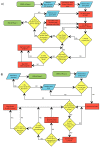GO Trimming: Systematically reducing redundancy in large Gene Ontology datasets
- PMID: 21798041
- PMCID: PMC3160396
- DOI: 10.1186/1756-0500-4-267
GO Trimming: Systematically reducing redundancy in large Gene Ontology datasets
Abstract
Background: The increased accessibility of gene expression tools has enabled a wide variety of experiments utilizing transcriptomic analyses. As these tools increase in prevalence, the need for improved standardization in processing and presentation of data increases, as does the need to guard against interpretation bias. Gene Ontology (GO) analysis is a powerful method of interpreting and summarizing biological functions. However, while there are many tools available to investigate GO enrichment, there remains a need for methods that directly remove redundant terms from enriched GO lists that often provide little, if any, additional information.
Findings: Here we present a simple yet novel method called GO Trimming that utilizes an algorithm designed to reduce redundancy in lists of enriched GO categories. Depending on the needs of the user, this method can be performed with variable stringency. In the example presented here, an initial list of 90 terms was reduced to 54, eliminating 36 largely redundant terms. We also compare this method to existing methods and find that GO Trimming, while simple, performs well to eliminate redundant terms in a large dataset throughout the depth of the GO hierarchy.
Conclusions: The GO Trimming method provides an alternative to other procedures, some of which involve removing large numbers of terms prior to enrichment analysis. This method should free up the researcher from analyzing overly large, redundant lists, and instead enable the concise presentation of manageable, informative GO lists. The implementation of this tool is freely available at: http://lucy.ceh.uvic.ca/go_trimming/cbr_go_trimming.py.
Figures

References
-
- Ashburner M, Ball C, Blake J, Botstein D, Butler H, Cherry J, Davis A, Dolinski K, Dwight S, Eppig J, Harris M, Hill D, Issel-Tarver L, Kasarskis A, Lewis S, Matese J, Richardson J, Ringwald M, Rubin G, Sherlock G, Consortium GO. Gene Ontology: tool for the unification of biology. Nat Genet. 2000;25(1):25–29. doi: 10.1038/75556. - DOI - PMC - PubMed
-
- Ashburner M, Ball C, Blake J, Butler H, Cherry J, Corradi J, Dolinski K, Eppig J, Harris M, Hill D, Lewis S, Marshall B, Mungall C, Reiser L, Rhee S, Richardson J, Richter J, Ringwald M, Rubin G, Sherlock G, Yoon J, Consortium GO. Creating the gene ontology resource: Design and implementation. Genome Res. 2001;11(8):1425–1433. doi: 10.1101/gr.180801. - DOI - PMC - PubMed
LinkOut - more resources
Full Text Sources
Research Materials
Miscellaneous

